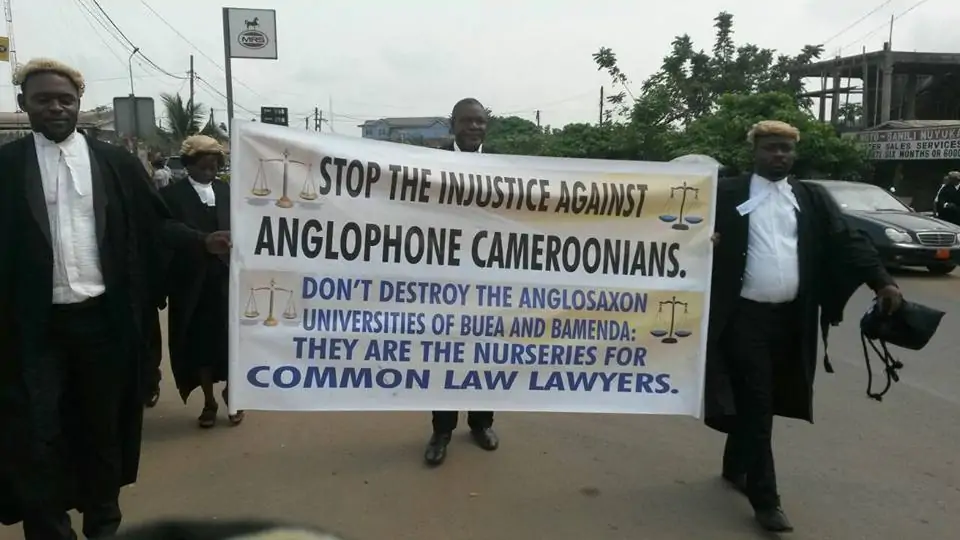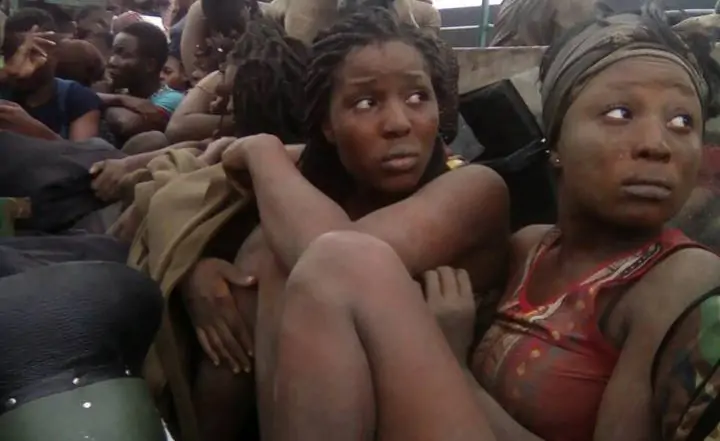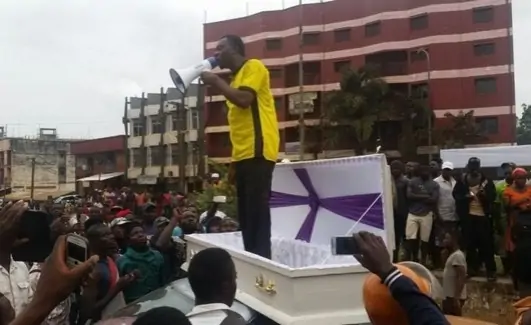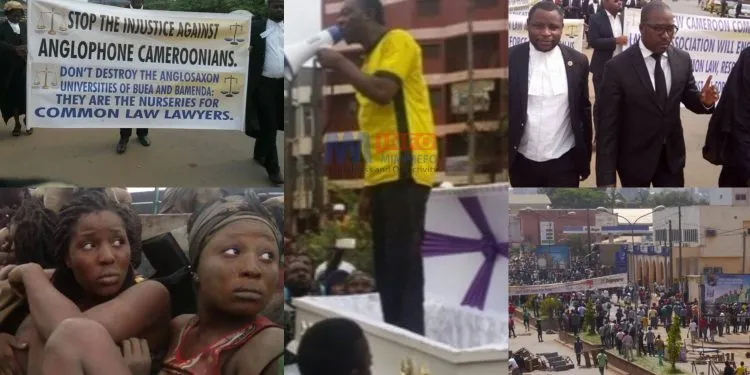The armed conflict in the North West and South West regions of Cameroon, often referred to as the Anglophone Crisis, began with professional demands from lawyers and teachers, degenerating into a full-blown separatist conflict. Though marginalisation and the progressive absorption of the Anglo-Saxon system by the predominantly Francophone system can be traced as the root cause of the agitations, the events of 2016 quickly set a new watershed moment in the history of the crisis.
How it all started: Professional Demands
Lawyers’ Demands (11 October 2016):
While there have been Anglophone agitations for many decades, the current crisis began on 11 October 2016 in Bamenda when lawyers from the Northwest and the Southwest went on strike. Their demands, ignored until then by the justice ministry, centred around the justice system’s failure to use the Common Law in the two regions. The lawyers demanded the translation into English of the Code of the Organisation for the Harmonisation of Business Law in Africa (OHADA) and other legal texts. They criticised the “francophonisation” of Common Law jurisdictions, with the appointment of Francophone magistrates who did not understand English or the Common Law. There was also the appointment of notaries, to do work done by lawyers under the Common Law system. A lack of trust in the government and the brutality of the security forces aggravated the problem.
On 8 November 2016, the lawyers mobilised hundreds of people for a march in Bamenda and reiterated their demand for the full restoration of the Common Law system as it was at the time of the two-state federation. They added a demand for federalism. While the march was taking place peacefully, gendarmes violently dispersed the crowd, manhandled some lawyers, and arrested some motorbike taxi drivers (“Okada boys”). In response, some youth and Okada boys set up barricades at several crossroads, and clashes between demonstrators and gendarmes left several wounded.

Teachers’ Strike (21 November 2016):
On 21 November, teachers went on strike as well. The Teachers Association of Cameroon (TAC), the Cameroon Teachers’ Trade Union (CATTU), the Syndicate of Higher Education Teachers (SNYES), and others protested the hiring of Francophone teachers in Anglophone schools, the use of French as the language of instruction, and the curriculum’s incompatibility with the Anglophone education subsystem. They organised a rally against the lack of Anglophone teachers, the appointment of teachers who did not have a good command of English, and the failure to respect the “Anglo-Saxon” character of schools and universities in the Anglophone zone.
At the rally, several thousand people joined teachers to express grievances ranging from the lack of roads in the Northwest to the marginalisation of Anglophones. The police and the gendarmarie violently dispersed the demonstrators. Several people were brutally beaten, dozens of others were arrested, and at least two people were shot dead, according to a report by the National Commission on Human Rights and Freedoms (Commission Nationale des droits de l’Homme et des libertés, CNDHL). Several other incidents took place in Bamenda at the end of November, leading to riots
The University of Buea Brutality:
On November 28, 2016, the crisis, which had until then been limited to the Northwest, spread to the Southwest. Students at the University of Buea organised a peaceful march on the campus to call for the payment to students of the president’s achievement bonus, denounce the ban of the University of Buea Student Union (UBSU) in 2012. They also protested the introduction of a penalty for late payment of education fees and the additional fee charged for accessing examination results. The response of the Vice Chancellor, Nalova Lyonga, was to call the police onto the campus. They brutally repressed the students and arrested some of them in their homes. Female students were beaten, undressed, and forced to roll in mud, and one was allegedly raped.

The CPDM Rally in Bamenda:
The most violent confrontation took place on 8th December 2016 in Bamenda when the CPDM tried to organise a pro-government rally in the Anglophone regions. The angry crowd prevented the rally from taking place. In violent clashes, four died, several were wounded, and around 50 were arrested. Demonstrators set fire to a police station, government buildings, and vehicles. The prime minister, the CPDM secretary general, the governor of the Northwest region, and the national security adviser, who were due to attend the rally, had to hide all day in the governor’s residence to escape the violence. The government responded to these demonstrations by militarising the region, causing the security climate to deteriorate even further.
The violence in Buea on 28 November and in Bamenda on 8 December aggravated the crisis and led to extensive media coverage. Images of abuses by the security forces quickly spread on the internet and onto international television channels. They had a decisive impact on public opinion and opened the Pandoras’ box of the Anglophone problem.
Mancho Bibixy’s Coffin Revolution
Mancho Bibixy, a radio presenter, became one of the most iconic figures in the Anglophone struggle with his Coffin Revolution on November 21, 2016, in Bamenda. Standing in an empty coffin, he led protests against poor infrastructure, police brutality, and the neglect of Anglophone rights by the government.
The coffin symbolised the “death” of Anglophone rights and opportunities. Mancho’s dramatic act drew attention to the growing frustrations of the Anglophone population. Like many others, Mancho was eventually arrested and sentenced to 15 years in prison, which further galvanised the movement.

From October 2016 to February 2017, at least nine people were killed.
Further incidents took place in January and February 2017 in Bamenda and other towns, such as Ndop. They led to riots that left at least three dead, while government buildings and vehicles were set on fire. From October 2016 to February 2017, at least nine people were killed, and more sustained gunshot wounds. There were 82 arrests, including of journalists and lawyers, according to the communications minister, and about 150 according to the SDF. They appeared before a military court under the terrorism law. The security forces also arrested and intimidated prominent Anglophones. For example, Paul Abine Ayah, a judge at the Supreme Court, was arrested without a warrant in March on charges of funding the Anglophone campaign. He has since remained behind bars.
The Government and Anglophone Actors: Strategies and Motivations
Faced with the Anglophone crisis, the government tried to maintain the status quo. However, realising there were limits to what it could achieve with repression, it began talks with the striking unions. At the end of November, the prime minister formed an ad hoc inter-ministerial committee charged with leading negotiations. It comprised four Francophone ministers and was placed under the supervision of the prime ministry’s cabinet director. At the start of December, the lawyers and teachers formed the Cameroon Anglophone Civil Society Consortium (CACSC, “the Consortium”). Four lawyer associations and a number of teacher trade unions initially formed it, with Félix Khongo Agbor Balla serving as president, Fontem Neba serving as secretary general, and Wilfred Tassang serving as treasurer.
On 25-26 November, the prime minister unsuccessfully conducted a first mission to Bamenda to open negotiations. He arrived without concrete proposals, perhaps expecting that the promise of dialogue and his presence would be enough to end the strike. This visit was an early sign of the divisions within the Anglophone elites working within government institutions in Yaoundé.
While the prime minister recognised the existence of the Anglophone problem and invited the trade unions for talks in Bamenda, other prominent Anglophones, such as the minister and permanent secretary at the National Security Council told the media in Yaoundé that there was no Anglophone problem. This inflamed opinion in the region, making the prime minister’s mission impossible and, especially, confirming the Anglophone belief that the prime minister, a post occupied since 1996 by an Anglophone, had no real power.
From December 2016 to January 2017, the ad hoc committee conducted several missions to Bamenda. The list of union demands increased from eleven to 25 between November and January but negotiations nearly reached an agreement, with the government saying it was ready to meet 21 of the 25 demands. However, on 13 January, police abuses, against a backdrop of rumours, provoked riots in Bamenda and the negotiations collapsed. On 14 January, the Consortium cancelled a meeting with the committee, condemned the violence perpetrated by the security forces and declared a two-day Operation Ghost Town in the Northwest and the Southwest. The government responded by shutting down the internet in the two regions on 17 January, banning the Consortium and the SCNC and arresting Consortium leaders and several activists such as Mancho Bibixy, claiming that the Consortium had conditioned agreement on the introduction of federalism.
Events that marked the 13th January, 2017 meeting in Bamenda marked a decisive break in attempts at dialogue. Some school of thoughts said that the security forces opened fire at point-blank range on motorbike taxis. Others said that Anglophone movement radicals tried to introduce the issue of secession into the debate, with the result that both sides hardened their positions. Although these incidents contributed to the failure of negotiations, they were not the only reason.
In fact, the tension in the two regions, the repression by the security forces and the radicalisation of public opinion had put Consortium leaders in a difficult position. They were forced to go beyond their own sectoral demands – especially as the 21 points accepted by the government only included the teachers’ demands, not the lawyers’ demands and to deal more broadly with the Anglophone problem. According to a Consortium leader, “repression by the regime has opened a Pandora’s box and the public has forced us to put the Southern Cameroons issue on the table.”
The ad hoc committee did not inspire much confidence, because most of its members were Francophones.
Negotiations were difficult because of the deep distrust between the government and representatives of the Anglophone community. The ad hoc committee did not inspire much confidence, because most of its members were Francophones. Consortium members did not believe that the government would keep its promise to meet 21 of its 25 demands. So, they proposed federalism in order to guarantee implementation of reforms and achieve a more general solution. Meanwhile, the government believed that the trade unions had a hidden agenda involving secession and that this was why they continually added to their list of demands.
Probably to avoid the crisis spreading to the Francophone part, the government brandished the spectre of secession by conflating Anglophone grievances and the division of the country. Some Francophone intellectuals said that federalism was only a step on the road to secession.
There were some indications, such as the positions taken during the negotiations and confirmed in several interviews, that some members of the regime in Yaoundé tried to strengthen the position of the more radical Anglophones with the aim of presenting the Anglophone contestation as a dangerous attempt to divide the country. The government also claimed there was a plot, presenting the Anglophone strike as an initiative funded by the diaspora and supported by groups who were trying to destabilise Cameroon.
Disbandment of the Consortium and Arrests of Leaders (January 2017)
On 17th January 2017, the government disbanded the Cameroon Anglophone Civil Society Consortium and declared it an illegal organization. Leaders such as Agbor Balla and Dr. Fontem Neba were arrested and charged with terrorism and rebellion.
The arrests were seen as a declaration of war on Anglophones, pushing many to abandon hopes for a peaceful resolution and radicalizing segments of the population. Leadership shifted to the Anglophone diaspora, who took on a more prominent role in the struggle for independence.
Internet Shutdown (17th January 2017)
In an attempt to suppress dissent and limit communication between Anglophones, the government imposed an internet shutdown in the North West and South West regions. The blackout lasted nearly three months (from January to April 2017) and further fuelled resentment. During this period, Anglophone leaders abroad gained more influence and began pushing for a more radical solution: independence.
Transfer of Leadership Abroad and Radicalization of the Movement
With many leaders in Cameroon either arrested or in hiding, the Anglophone leadership transitioned to the diaspora, Mark Bareta and Tapang Ivo, particularly in the United States, Canada, and Europe. These leaders began advocating for the full independence of the Anglophone regions under the banner of Ambazonia.
The Southern Cameroons Ambazonia Consortium United Front (SCACUF) was formed, and its leaders declared the formation of an independent state of Ambazonia.
Peace Plant March (September 22, 2017)
On September 22, 2017, thousands of Anglophones took to the streets in a peaceful protest, carrying peace plants (branches used as symbols of peace) and demanding justice, the release of their leaders, and the recognition of their rights. Despite the peaceful nature of the protests, security forces responded with violence, leading to deaths and injuries.
October 1, 2017: Declaration of Ambazonia’s Independence
On October 1, 2017, Anglophone leaders in the diaspora declared the independence of Ambazonia. Large-scale protests erupted across the Anglophone regions, where protesters raised the Ambazonian flag and called for secession.
The government responded with heavy military force, leading to dozens of deaths and mass arrests. This marked a turning point as armed groups began to form, and violence became widespread.
Killing of Gendarmes in Agborkem German, Mamfe (November 2017)
In November 2017, separatist fighters ambushed and killed four gendarmes in Agborkem German, a town in Mamfe. This marked the beginning of organised armed resistance, with separatist groups launching attacks on security forces.
Emergence of Armed Groups
Various armed groups emerged, the most prominent being:
Ayaba Cho Lucas is the leader of the Ambazonia Defense Forces (ADF), one of the best-known and most well-organized separatist organizations.
Another important group in the armed conflict is the Southern Cameroons Defense Forces (SOCADEF), which is under the leadership of Ebenezer Akwanga.
Other smaller groups include the Red Dragons, 7 katters of Bafut, Tigers of Ambazonia, and splinter groups, each operating in different parts of the Anglophone regions.
Actions Taken to Resolve the Conflict
Major National Dialogue (30th September- 4th October 2019): President Paul Biya called for a national dialogue to resolve the crisis. Held in Yaoundé, the dialogue included various stakeholders but was boycotted by major separatist groups. Recommendations included the granting of “special status” to the North West and South West regions, but the dialogue failed to stop the fighting.
Swiss Mediation (2019-2020): Switzerland, through the Centre for Humanitarian Dialogue, attempted to mediate between the government and separatist groups. However, the process was stalled due to mistrust, and many separatist leaders refused to participate.
Canadian Mediation (2023): In January 2023, Canada announced it had been invited to facilitate negotiations between the Cameroonian government and the separatists. This effort raised hope, but the Cameroonian government soon denied involvement, casting doubt on the process.
Other Pacific Measures: Various international actors, including the UN and the African Union, have called for peace and dialogue. Countries like the United States have imposed sanctions on Cameroonian officials involved in human rights abuses.
After the arrest of Consortium leaders on 17 January, continued school closures, and an intensification of Operation Ghost Town, the government took measures in the justice and education sectors to try to calm the situation. In December 2016, it had already announced the recruitment of 1,000 bilingual teachers, an FCFA 2 billion (€3 million) grant to private schools and the redeployment of Francophone teachers away from Anglophone regions.
On 23 January 2017, the president of the Republic created a National Commission for Bilingualism and Multiculturalism. But Anglophone militants criticised this as too little too late and regretted that nine of the commission’s fifteen members were Francophones, that most of them belonged to the older generation, and that several were members of the CPDM. The commission is handicapped by its remit, which gives it no power to impose punitive measures, and restricts it to preparing reports and advocating for bilingualism and multiculturalism. Some of its members have recognised this weakness.
The government announced other measures on 30 March, including the creation of new benches for Common Law at the Supreme Court and new departments at the National School of Administration and Magistracy (Ecole nationale d’administration et de magistrature, ENAM), an increase in the number of English language teachers at ENAM, the recruitment of Anglophone magistrates, the creation of a Common Law department at Francophone universities, and provisional authorisation for Anglophone lawyers to act as notaries in the Northwest and the Southwest regions.
On 20 April, the government turned the internet back on after a 92-day cut. Although these measures were a significant first step, they did not meet the concerns of the trade unions or resolve the political component of the Anglophone question. They were made rather late in the day, when the public were already calling for the release of detainees and negotiations on constitutional reform with the aim of introducing federalism.
Anglophones continued to take action. When the internet was cut, protesters used text messages and phone calls to organise protests. When it was restored, they reverted to mainly using WhatsApp. More recently, the campaign has nevertheless weakened, especially in the Southwest, partly because the economic consequences have become hard to bear for the public and also because of government pressure. New radical groups are using intimidation, threats and violence to maintain support for the movement.
The public, elected representatives, parliamentarians and religious leaders regularly receive text messages and calls from Cameroon and abroad, informing them of Ghost Town days, now called Country Sundays. For example, a Francophone teacher at the University of Buea received eleven text messages and six telephone calls in a single day after ignoring a call to take part in Operation Ghost Town. Country Sundays take place every Monday and every national holiday or commemoration day. Anyone not adhering to the movement faces harassment and threats.
Humanitarian Actions and Crisis Management
The Anglophone crisis has displaced over 700,000 people, with many fleeing to Nigeria or becoming internally displaced. Humanitarian organisations, including the United Nations, have provided food, shelter, and medical care to those affected, but access to conflict areas remains challenging.
The Cameroonian government launched a Reconstruction Plan for the North West and South West regions, aimed at rebuilding infrastructure



